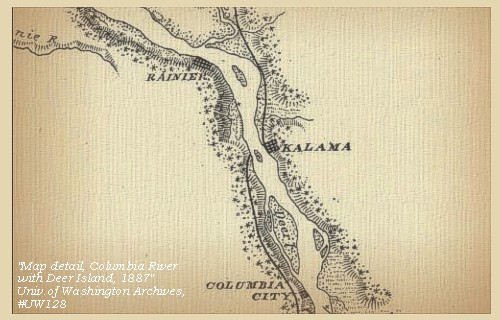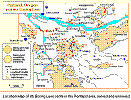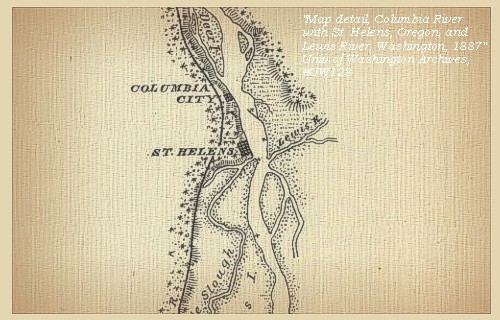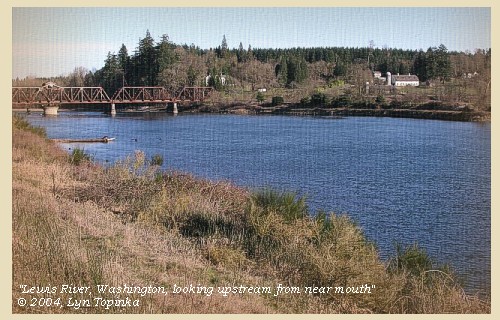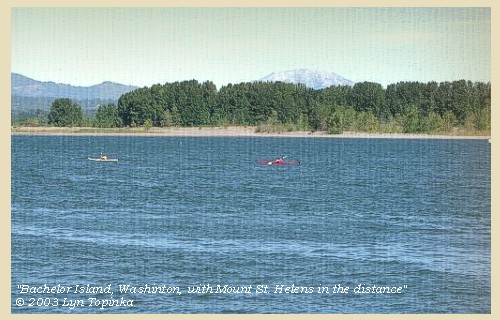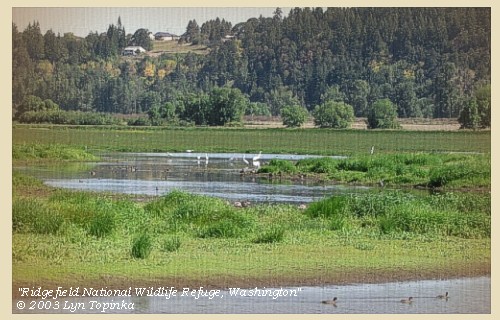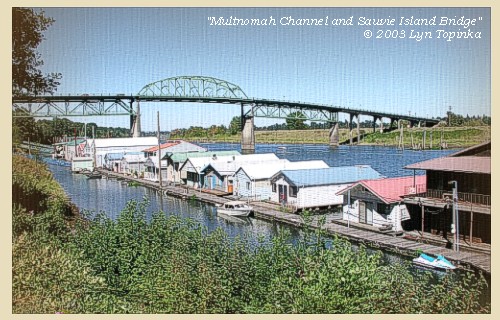
Multnomah Channel:
Multnomah Channel has also been known as the Willamette Slough (1887 map). The channel separates Sauvie Island from mainland Oregon, and is a favorite recreation spot of boaters.







- 1814 Map, Lewis and Clark's map of the Columbia River (section of original). (Click to enlarge.) The Multnomah Channel is depicted but not named.
Map includes three of the five volcanoes Lewis and Clark saw and commented on. While the journals mention the expedition seeing Mount Adams, it does not appear on their map. Mount Jefferson is to the south (bottom) and off the map.
From the "Nicholas Biddle/Paul Allen" 1814 publication.
Original Map: "A Map of Lewis and Clark's Track, Across the Western Portion of North America, From the Mississippi to the Pacific Ocean".
From: History of the expedition under the command of Captains Lewis and Clark : to the sources of the Missouri, thence across the Rocky Mountains and down the river Columbia to the Pacific Ocean : performed during the years 1804-5-6 : by order of the government of the United States / prepared for the press by Paul Allen. Philadelphia : Bradford and Insskeep, 1814.
Harold B. Lee Library, Brigham Young University #upbover maps37.
-- Brigham Young University, Harold B. Lee Library Website, 2004.
- 1853-54 Map, Columbia River, including the Fort Vancouver area (section of original). (Click to enlarge).
Sauvie Island is depicted but not named, and so is the Multnomah Channel which separates Sauvie Island from the Oregon mainland.
Includes Longview, Washington (Monticello), Coweeman River (Minter R.), Kalama River (Ca-la-ma R.),
Lewis River (Cath-la-pootle R.), Willamette River, Fort Vancouver, Cape Horn, and "The Cascades". Vancouver Lake is depicted but not labeled.
Original Map: "Rocky Mountains to Puget Sound : from explorations and surveys / made under the direction of the Hon. Jefferson Davis, Secretary of War by Isaac I. Stevens Governor of Washington Territory, 1853-4."
Inset: (Supplementary sketch) Reconnaissance of the railroad route from Wallawalla to Seattle via Yak-e-mah River & Snoqualmie Pass. By A. W. Tinkham in January 1854. Drawn by J. R. P. Mechlin. 20 x 28 cm.
Topographer, John Lambert, Published in Washington D.C., 1859, 1:1,200,000, Notes: From the U.S. War Department, Explorations and Surveys for a Railroad Route from the Mississippi River to the Pacific Ocean, Topographical Maps, to Illustrate the Various Reports, U.S. Library of Congress American Memories Reference "LC Railroad Maps #156".
-- U.S. Library of Congress, American Memories Website, 2004
- 1887 Map (section of original),
Columbia River and the Sauvie Island vicinity. (Click to enlarge).
Bachelor Island, while not named on the map, is the island south (below) the Lewis River (upper right). The Willamette Slough is today called the Multnomah Channel.
Original Map: The Columbia River from Celilo to the mouth showing locations of the salmon fisheries, 1887.
Scale ca. 1:375,000, Relief shown by hachures.
U.S. Army Corps of Engineers, Engineer Office, G.P.O. 1888.
University of Washington Archives #UW128.
-- University of Washington Library Archives Website, 2002
- 1988 Map, Downstream end of Sauvie Island, Bachelor Island, Multnomah Channel, Lewis River (section of original). (Click to enlarge).
Office of Coast Surveys, Historical Maps and Charts,
Columbia River, Saint Helens to Vancouver, 1988, Chart#18524, 1:40,000.
-- NOAA Office of Coast Survey Website, 2004
- 1994, NASA Image, Columbia River from Deer Island to the Willamette River
(section of original). (Click to enlarge).
View from space - north-northeast-looking, low-oblique photograph,
showing a section of the Columbia River from Deer Island to the Willamette River, including the Lewis River,
Sauvie Island, Bachelor Island, and the Ridgefield National Wildlife Refuge,
October 1994.
The Columbia River is flowing from lower right to upper left in this image (southeast to northwest).
Washington State is the upper right of the image and Oregon is
to the bottom left.
NASA Earth from Space #STS068-262-025.
-- NASA Earth from Space Website, 2002
- 1994, NASA Image, Columbia River and Sauvie Island
(section of original). (Click to enlarge).
View from space - north-northeast-looking, low-oblique photograph,
showing a section of the Columbia River and Sauvie Island, Oregon,
October 1994.
NASA Earth from Space #STS068-262-025.
-- NASA Earth from Space Website, 2002
- 2003, Multnomah Channel and Sauvie Island Bridge, taken from Oregon Highway 30. (Click to enlarge).
Copyright © 2003 Lyn Topinka, private archives, used with permission.
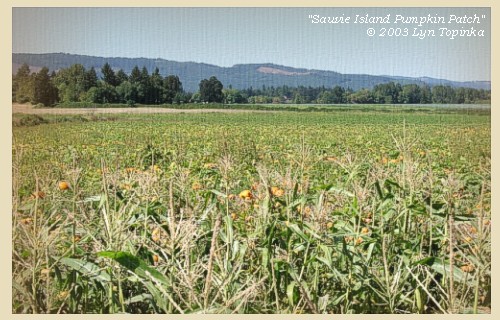
Sauvie Island:
Sauvie Island contains approximately
24,000 acres of land and lakes,
and had its origin in alluvial deposits
from the Columbia and Willamette rivers as their
velocities decreased by changes in direction
and by
lava extrusions located on the north
end.
The island is 16 miles long and 4.5 miles
at the widest point. The Sauvie Island
wildlife area includes 8,053 acres of
deeded land and 3,490 acres of land leased from the
Division of State Lands for wildlife
management purposes.
The island is bounded on the
east by the Columbia River; on
the south by the Willamette River
and on the west by the Multnomah Channel.
Across the
river on the Washington side,
Scappoose Bay provides fish and wildlife habitat.
-- Columbia Basin Fish and Wildlife Authority Website, 2002,
Oregon State Archives Website, 2002, and
Washington State Historical Society Website, 2002










- 1814 Map, Lewis and Clark's map of the Columbia River (section of original). (Click to enlarge.) Sauvie Island is labeled "Wappatoo I.".
Map also includes three of the five volcanoes Lewis and Clark saw and commented on. While the journals mention the expedition seeing Mount Adams, it does not appear on their map. Mount Jefferson is to the south (bottom) and off the map.
From the "Nicholas Biddle/Paul Allen" 1814 publication.
Original Map: "A Map of Lewis and Clark's Track, Across the Western Portion of North America, From the Mississippi to the Pacific Ocean".
From: History of the expedition under the command of Captains Lewis and Clark : to the sources of the Missouri, thence across the Rocky Mountains and down the river Columbia to the Pacific Ocean : performed during the years 1804-5-6 : by order of the government of the United States / prepared for the press by Paul Allen. Philadelphia : Bradford and Insskeep, 1814.
Harold B. Lee Library, Brigham Young University #upbover maps37.
-- Brigham Young University, Harold B. Lee Library Website, 2004.
- 1853-54 Map, Columbia River, including the Fort Vancouver area (section of original). (Click to enlarge).
Sauvie Island is depicted but not named.
Includes Longview, Washington (Monticello), Coweeman River (Minter R.), Kalama River (Ca-la-ma R.),
Lewis River (Cath-la-pootle R.), Willamette River, Fort Vancouver, Cape Horn, and "The Cascades". Vancouver Lake is depicted but not labeled.
Original Map: "Rocky Mountains to Puget Sound : from explorations and surveys / made under the direction of the Hon. Jefferson Davis, Secretary of War by Isaac I. Stevens Governor of Washington Territory, 1853-4."
Inset: (Supplementary sketch) Reconnaissance of the railroad route from Wallawalla to Seattle via Yak-e-mah River & Snoqualmie Pass. By A. W. Tinkham in January 1854. Drawn by J. R. P. Mechlin. 20 x 28 cm.
Topographer, John Lambert, Published in Washington D.C., 1859, 1:1,200,000, Notes: From the U.S. War Department, Explorations and Surveys for a Railroad Route from the Mississippi River to the Pacific Ocean, Topographical Maps, to Illustrate the Various Reports, U.S. Library of Congress American Memories Reference "LC Railroad Maps #156".
-- U.S. Library of Congress, American Memories Website, 2004
- 1887 Map (section of original),
Columbia River and the Sauvie Island vicinity. (Click to enlarge).
Bachelor Island, while not named on the map, is the island south (below) the Lewis River.
Original Map: The Columbia River from Celilo to the mouth showing locations of the salmon fisheries, 1887.
Scale ca. 1:375,000, Relief shown by hachures.
U.S. Army Corps of Engineers, Engineer Office, G.P.O. 1888.
University of Washington Archives #UW128.
-- University of Washington Library Archives Website, 2002
- 1988 Map, Downstream end of Sauvie Island, Bachelor Island, Multnomah Channel, Lewis River (section of original). (Click to enlarge).
Office of Coast Surveys, Historical Maps and Charts,
Columbia River, Saint Helens to Vancouver, 1988, Chart#18524, 1:40,000.
-- NOAA Office of Coast Survey Website, 2004
- 1994, NASA Image, Columbia River from Deer Island to the Willamette River
(section of original). (Click to enlarge).
View from space - north-northeast-looking, low-oblique photograph,
showing a section of the Columbia River from Deer Island to the Willamette River, including the Lewis River,
Sauvie Island, Bachelor Island, and the Ridgefield National Wildlife Refuge,
October 1994.
The Columbia River is flowing from lower right to upper left in this image (southeast to northwest).
Washington State is the upper right of the image and Oregon is
to the bottom left.
NASA Earth from Space #STS068-262-025.
-- NASA Earth from Space Website, 2002
- 1994, NASA Image, Columbia River and Sauvie Island
(section of original). (Click to enlarge).
View from space - north-northeast-looking, low-oblique photograph,
showing a section of the Columbia River and Sauvie Island, Oregon,
October 1994.
NASA Earth from Space #STS068-262-025.
-- NASA Earth from Space Website, 2002
- 1992, NASA Image, Columbia River, Portland, Oregon, and Vancouver, Washington (section of original). (Click to enlarge).
View from space - west-looking, low-oblique photograph,
showing a section of the Columbia River with Government Island, the Sandy River, Portland, Oregon, and Vancouver,
Washington, September 1992. The Columbia River is flowing from bottom (east) to top (west).
NASA Earth from Space #STS047-096-066.
-- NASA Earth from Space Website, 2002
- 1992, NASA Image, Columbia River upstream of Vancouver, Washington,
showing Bachelor Island and the Ridgefield National Wildlife Refuge (section of original). (Click to enlarge).
View from space - west-looking, low-oblique photograph,
showing a section of the Columbia River upstream of Vancouver, Washington, September 1992.
Bachelor Island is on the right side of the image, just barely discernible as an island (light colored yellowish area).
Bachelor Island Slough separates Bachelor Island from the mainland. The area next to the Columbia on the right and the left
side of Bachelor Island is part of the Ridgefield National Wildlife Refuge. The upper half of the image is Sauvie Island,
with the Willamette River on it's left, the Columbia River on the bottom, and the Multnomah Channel on the upper side.
NASA Earth from Space #STS047-096-066.
-- NASA Earth from Space Website, 2002
- 2003, Multnomah Channel and Sauvie Island Bridge, taken from Oregon Highway 30. (Click to enlarge).
Copyright © 2003 Lyn Topinka, private archives, used with permission.
- 2003, Sauvie Island pumpkin patch. (Click to enlarge).
Copyright © 2003 Lyn Topinka, private archives, used with permission.
|


